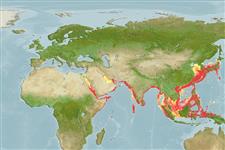Preferred temperature (Ref.
123201): 11.6 - 23.2, mean 17.4 °C (based on 401 cells).
Phylogenetic diversity index (Ref.
82804): PD
50 = 0.6250 [Uniqueness, from 0.5 = low to 2.0 = high].
Bayesian length-weight: a=0.00427 (0.00162 - 0.01121), b=3.06 (2.84 - 3.28), in cm total length, based on LWR estimates for this (Sub)family-body shape (Ref.
93245).
Trofisk nivå (Ref.
69278): 4.4 ±0.67 se; based on food items.
Generation time: 5.8 ( na - na) years. Estimated as median ln(3)/K based on 1
growth studies.
Resiliens (Ref.
120179): Mellan, lägsta populationsfördubblingstid 1,4-4,4 år (Tmax=15; K=0.19-0.33; Min Rel Fec=153).
Prior r = 0.57, 95% CL = 0.37 - 0.85, Based on 3 data-limited stock assessments.
Fishing Vulnerability (Ref.
59153): High vulnerability (62 of 100).
🛈
Climate Vulnerability (Ref.
125649): Very high vulnerability (85 of 100).
🛈
Nutrients (Ref.
124155): Calcium = 30.7 [16.9, 59.0] mg/100g; Iron = 0.831 [0.484, 1.436] mg/100g; Protein = 19.1 [16.9, 21.6] %; Omega3 = 0.339 [0.157, 0.993] g/100g; Selenium = 66.3 [35.3, 123.9] μg/100g; VitaminA = 6.96 [2.12, 22.85] μg/100g; Zinc = 0.412 [0.295, 0.612] mg/100g (wet weight);
